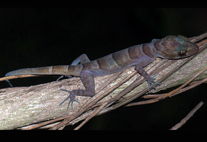Abstract
Recent taxonomic studies on Neotropical mammals have benefited from the use of genetic data to unravel and recognize species diversity in a number of genera, including the Atlantic forest endemic genus Delomys. However, the success of this approach depends on ability to link genetically identified lineages to species names based on voucher specimens that lack genetic data. Cytogenetic studies in the Atlantic forest endemic rodent genus Delomys have revealed two widespread karyotypes, 2n=72/FN=90 and 2n=82/FN=80, which have been respectively ascribed to Delomys sublineatus (Thomas, 1903) and D. dorsalis (Hensel, 1872). More recently, a third karyotype, 2n=82/FN=86, reported from specimens collected on two montaintops in southeastern Brazil, was interpreted as evidence for a third species, D. collinus Thomas, 1917. This nominal form had originally been described as a subspecies of D. dorsalis from Itatiaia, one of the mountain ranges where the third karyotype was later detected. The detection of two sympatric karyotypes at the type locality of D. collinus in the Itatiaia mountain range, Southeastern Brazil, prompted a reevaluation of the association of karyomorphs and species names. In this paper, we assessed the congruence of molecular (cytochrome b), cytogenetic and morphological characters, to diagnose the species in the genus, including data from recently collected series and type specimens. Our results indicate that the genetic and morphological patterns are largely congruent with the recognition of three species, each of which is karyotypically and morphologically diagnosable. Our morphological analyses of sympatric samples from Itatiaia refute the former association of the 2n=82/FN=86 karyotype with the holotype of D. dorsalis collinus (which is more similar to D. dorsalis with 2n=82/FN=80). Instead, we recognize and describe a new species for the 2n=82/FN=86 populations from the highest altitudinal zones of the Itatiaia and Caparaó mountains. The geographical variation in D. dorsalis is also explored and the status of D. d. collinus is discussed in the light of the molecular and morphological evidence. Finally, we discuss biogeographic hypotheses concerning the disjunct distributions of D. dorsalis and the new species.

